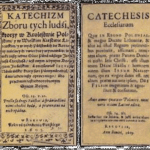Sunday Jan and I went out for what is becoming an at least once a month and often twice a month film and dinner.
We saw Carol.
It’s 1952. A young girl, Therese, an aspiring photographer working in a department store in Manhattan has a chance encounter with Carol who is looking for a present for her child. When Carol leaves her gloves at the counter, Therese mails them to her. Carol responds with an offer of lunch as a thank you. As their relationship unfolds, the complexities of their lives and the lives of those around them plays out against a lush recreation of the early nineteen fifties among affluent and very white Manhattanites.
A lot of the action plays over the faces of Therese portrayed by Rooney Mara and Carol played by Cate Blanchette. And it is amazing what the lift of an eyebrow or the turn of a lip can convey. (As an aside a homage to the big screen that allows this…) In many ways this is a small film, but at every turn offering the viewer a multiplicity of possible interpretations, giving the imagination the opportunity to run full riot, making small very large, indeed. I felt drawn in from close to the beginning and carried along all the way. It felt authentic. It felt sad. And ultimately it felt beautiful.
The Wikipedia entry about the film tells us “Carol is an adaptation of The Price of Salt, the 1952 lesbian romance novel by Patricia Highsmith, originally published under the pseudonym “Claire Morgan.” The semi-autobiographical novel fell out of print and was re-issued by lesbian publishing house Naiad Press in 1984; and republished by Bloomsbury as Carol in 1990 under Highsmith’s name. The character of Therese Belivet is based on Highsmith herself, after an encounter she had with a woman while working at Bloomingdale’s in New York City in 1948.”
The film has been received with pretty much universal acclaim. It received a standing ovation at its screening at the Cannes Film Festival. Praise has been lavished on the director Todd Haynes, Blanchett’s and Mara’s performances, the amazing cinematography, costuming, and score. My favorite review aggregator Rotten Tomatoes had its audience reviews give it a 76% positive score, and the professionals an astonishing 93% positive score. The “critics consensus” summary reads “Shaped by Todd Haynes’ deft direction and powered by a strong cast led by Cate Blanchett and Rooney Mara, Carol lives up to its groundbreaking source material.”
For me the film was stifling within its beauty, frightening within its gentility, and ultimately offering small hints at the promise ahead. The undercurrent of sophisticated Manhattan’s assumptions that on the one hand homosexuality was a mental illness but on the other that it was tolerated so long as one didn’t flaunt it proved a difficult needle to thread. As Carol showed, much to her peril. I found the film spoke to the near powerlessness of individuals in a world that doesn’t allow them a place was echoed in the way black characters were limited to servants and the background. I would be surprised if these passing images of people of color weren’t consciously made by the director, a hint at the various forms of polite oppression to be found in the most sophisticated circles. But, as I said earlier, the film is filled with opportunities for the viewer to fill in ambiguous spaces. Right to and very much including the ending.
Of course the thinking came later. The experience was lush, beautiful, haunting like waves flowing gently over and over.
A beautiful film.
A powerful film.
Highly recommended.













